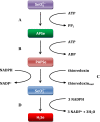Accumulation and metabolism of selenium by yeast cells
- PMID: 26003453
- PMCID: PMC4464373
- DOI: 10.1007/s00253-015-6650-x
Accumulation and metabolism of selenium by yeast cells
Abstract
This paper examines the process of selenium bioaccumulation and selenium metabolism in yeast cells. Yeast cells can bind elements in ionic from the environment and permanently integrate them into their cellular structure. Up to now, Saccharomyces cerevisiae, Candida utilis, and Yarrowia lipolytica yeasts have been used primarily in biotechnological studies to evaluate binding of minerals. Yeast cells are able to bind selenium in the form of both organic and inorganic compounds. The process of bioaccumulation of selenium by microorganisms occurs through two mechanisms: extracellular binding by ligands of membrane assembly and intracellular accumulation associated with the transport of ions across the cytoplasmic membrane into the cell interior. During intracellular metabolism of selenium, oxidation, reduction, methylation, and selenoprotein synthesis processes are involved, as exemplified by detoxification processes that allow yeasts to survive under culture conditions involving the elevated selenium concentrations which were observed. Selenium yeasts represent probably the best absorbed form of this element. In turn, in terms of wide application, the inclusion of yeast with accumulated selenium may aid in lessening selenium deficiency in a diet.
Figures





References
-
- Arnaudguilhem C, Bierla K, Ouerdane L, Preud’homme H, Yiannikouris A, Łobiński R. Selenium metabolomics in yeast using complementary reversed-phase/ hydrophilic ion interaction (HILIC) liquid chromatography-electro-spray hybrid quadrupole trap/Orbitrap mass spectrometry. Anal Chim Acta. 2012;757:26–38. doi: 10.1016/j.aca.2012.10.029. - DOI - PubMed
Publication types
MeSH terms
Substances
LinkOut - more resources
Full Text Sources
Other Literature Sources
Molecular Biology Databases

